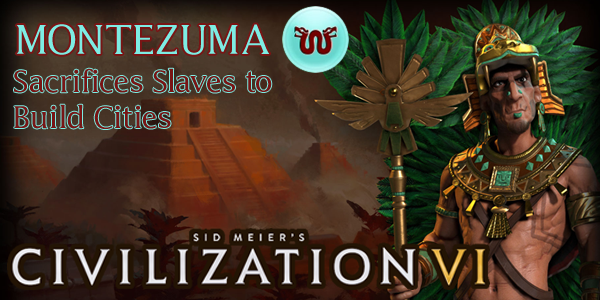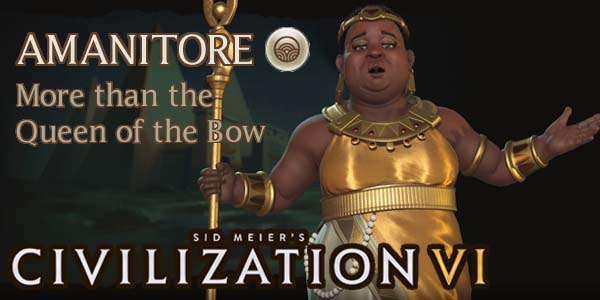
Now that I've covered all the civilizations which are new to the Civ franchise in the Gathering Storm expansion, I'm going to cover the other civs that my Patrons voted on. I'm going to start with Montezuma of the Aztecs. The Aztecs were included as DLC for the vanilla release of Civilization VI.
The Aztec Empire consisted of a "Triple Alliance" between the city states of Tenochtitlan, Texcoco, and Tlacopan in the Central Mexican Valley basin around Lake Texcoco, based largely around the cultivation of maize. They would subjugate other city states through military conquest, trade, or marriage, and then install governors to administer those client states without necessarily needing to maintain a military garrison. Client states would pay tribute directly to the Aztec emperor, who would limit their ability to communicate and trade directly with other client cities; thus, making each of the clients dependent on the empire for resources and luxury goods and reduce the likelihood of an uprising.

In the early 1500's, Spanish Conquistadors (lead by Hernán Cortéz) arrived in central Mexico and occupied the Aztec capital of Tenochtitlan, keeping Aztec Emperor Moctezuma Xocoyotzin a prisoner in his own palace. Since most of his history is depicted through the lens of the Spanish conquerors, information about Moctezuma's life and rule are limited and contradictory. He ruled the Aztec Empire at its territorial height after several successful military campaigns, and he imposed regressive policies that increased the rigidity of the Aztec caste system and severely limited the ability of commoners to work in royal palaces or ascend to nobility. Contrary to his typical depictions in the Civilization games as a blood-thirsty warmonger, contemporary Spanish writings suggest that Moctezuma may have been rather meek and was accommodating of the Spanish conquistadors, whom he invited to live in the palace as guests. Moctezuma would die during the Spanish occupation of Tenochtitlan, possibly having been stoned to death by his own citizens who were frustrated with his inability (or unwillingness) to repel the Spanish invaders.
DISCLAIMER:
Civilization VI is still a "living game". Strategies for the game (and for specific leaders and civs) may change as Firaxis applies balance patches, introduces new features, or expands the game through further DLC or expansion packs, or as the Civ community discovers new strategies or exploits. As such, the following strategy guide may change from time to time. I will try to keep it up-to-date, and will make notations whenever changes are made. I'll also post links in the official 2K forums and CivFanatics, where I'll also report any changes made. If possible and practical, I will try to retain the original content of the strategy for posterity.
I welcome any feedback or suggestions that readers wish to offer. Feel free to post on the linked forums, or by posting a comment at the bottom of the page.
This guide is up to date as of the release of the Gathering Storm expansion's "Red Death" update (ver. 1.0.0.341)
The Aztecs in Civilization VI are built to be highly aggressive, using the procurement of luxury resources to strengthen their armies and support their vast conquests.
[More]
1ebe4687-7bc0-4a01-9122-2d2756851b2b|1|5.0
Tags:Sid Meier's Civilization, Civilization VI, Aztec, Montezuma, legend of the five suns, gifts for the tlatoani, tlachtli, eagle warrior, tlatoani, luxury, amenity, war, loyalty, builder, slavery

With the first expansion for Civilization VI due out soon, I wanted to try to get one more pre-expansion game strategy out of the gates. This time, I will be covering another of the DLC civs that is making its first appearance in the Civilization franchise: Nubia. If you purchased the Deluxe Edition of the game, then you received this DLC (among others) for free when the DLC was released. If you do not own the Deluxe Edition, then this DLC costs $5 USD.
Egypt wasn't the only grand ancient civilization that made a home along the Nile River. Starting around 5000 BC, into the 1500's AD, Egypt's southern neighbor was one of the many Kingdoms of Nubia that rose and fell. The Nubians who settled along the river were expert archers, and the contemporary Egyptians (who traded for Nubian gold, ebony, and pottery) referred to their land as "Ta-Seti", or "The Land of the Bow". But the history of civilization in the Nubian region goes back to the Neolithic revolution that occurred in Africa around 5000 BC. Archaeologists have found rock reliefs and even an astronomical stone circle that predates Stonehenge by roughly 2,000 years!

Kandake ["Queen"] Amanitore co-ruled Nubia from her capital at the Gebel Barkal in Meroë starting around 1 BC. The Nubian civilization had a maternal rule, with the mothers of kings having authority over their sons, and sometimes even deposing them or ordering them to commit suicide if the mother believed them to be unfit as rulers. Amanitore's kingdom was wealthy and prosperous at this time, and Amanitore oversaw the construction and repair of multiple Temples to Amun throughout her kingdom, as well as the construction of Nubian Pyramids. She is regarded as one of the greatest builders in her people's history, and is believed to be buried underneath one of her Pyramids in Meroë.
DISCLAIMER:
Civilization VI is still very early in its life-cycle. Strategies for the game (and for specific leaders and civs) may change as Firaxis applies balance patches, introduces new features, or expands the game through DLC or expansion packs, or as the Civ community discovers new strategies. As such, the following strategy guide may change from time to time. I will try to keep it up-to-date, and will make notations whenever changes are made. I'll also post links in the official 2K forums and CivFanatics, where I'll also report any changes made. If possible and practical, I will try to retain the original content of the strategy for posterity.
I welcome any feedback or suggestions that readers wish to offer. Feel free to post on the linked forums, or by posting a comment at the bottom of the page.
This guide is up to date as of the Fall 2017 patch (ver. 1.0.0.194) (Southeast Asia DLC)
In Civilization VI, Nubia is a militaristic and religious civilization that specializes in rapidly developing city districts, especially in desert terrain... [More]
77d297db-8400-4835-a27b-1176e274e25d|2|5.0
Tags:Sid Meier's Civilization, Civilization VI, Nubia, Amanitore, Ta-Seti, Kandace of Meroe, city planner, pitati archer, archer, pyramid, Nubian Pyramid, mine, gold, luxury, strategic resource, war, district, production, adjacency bonus, Gebel Barkal, Meroe, Egypt, Neolithic revolution, stone circle, unique improvement, unique ranged unit
UPDATE (September 9, 2014, 2:45 PM Pacific Time)
Shortly after publishing this blog, I came across a forum post that contradicts the information presented in this blog post. As such, I will review the actual source code in the Civilization V dll, do some more testing with the game, and revise the post as necessary. In the meantime, I'll leave the unaltered post here, for posterity. I apologize for the inconvenience.
A lot of buildings in Civilization V mention that they are affected by tiles or resources "near the city", but this quality of being "near a city" is poorly-defined within the game. So what exactly does it mean? I haven't seen any in-depth articles about this topic on the web or in the game's Civilopedia, so I thought I'd outline the important bits here.
Basically, a tile is "near" a city if that city was the first city in its respective empire to claim that tile within its workable radius.
So if you have a single tile or resource that lies between two cities, and both cities' workable ranges overlap that same tile, then that tile is not "near" both cities. It is only "near" the first city that owned that tile. This means that if you go into the city management screen and assign the second city to work that tile, it may receive yield bonuses associated with any improvements or buildings that affect it (such as the stable buffing pasture resources), but the tile's contents will not be considered "near" that second city for other purposes. This includes:
- requirement of an improved Horse or Ivory to build a Circus,
- requirement of an improved Horse, Cow, or Sheep to build a Stable,
- requirement of an improved Iron to build a Forge,
- requirement of an improved Stone or Marble to build a Stone Works,
- requirement of an improved Gold or Silver to build a Mint,
- wonder production bonus from nearby Marble,
- requirement that the city be adjacent to a Mountain in order to build an Observatory,
- trade route income from resource diversity,
- and so on...
Say you have two cities (for example Rome and Antium) whose workable ranges overlap a pastured Horse. Rome was the first city to claim the Horse tile. Rome can, therefore, build a Circus (assuming Trapping has been researched). If you go to the management screen of Antium, you can assign it to work the Horse tile (which prevents Rome from being able to work that tile), but Antium still cannot build a Circus. That is, two cities cannot build a building that requires they both have the same tile.
[LEFT] Rome has annexed a tile containing horses and is building a Circus.
[RIGHT] Later, that tile overlaps with Antium's workable radius, but it cannot build a Circus because the horse was originally claimed by Rome.
Alternatively, if a resource is claimed by a city's culture, but is outside of a city's workable radius (four tiles or more away), then it never counts as "near" that city... [More]
c178571d-236f-4930-b087-5ba4b365ee97|0|.0
Tags:Sid Meier's Civilization, Civilization V, Civilization, Civilization V: Gods & Kings, Civilization V: Brave New World, Civilization: Beyond Earth, building, near, resource, luxury, resource diversity, Arabia, bazaar, Poland, Portugal, mare clausum, trade route, circus, stable, forge, stone works, mint, city borders, owned tiles, Ducal Stable, Civilization V
|

| 12 | | | | | | | 60 | | 11 | | | | | | | 55 | | 10 | | | | | | | 50 | | 09 | | | | | | | 45 | | 08 | | | | | | | 40 | | 07 | | | | | | | 35 | | 06 | | | | | | | 30 | | 05 | | | | | | | 25 | | 04 | | | | | | | 20 | | 03 | | | | | | | 15 | | 02 | | | | | | | 10 | | 01 | | | | | | | 05 |
|